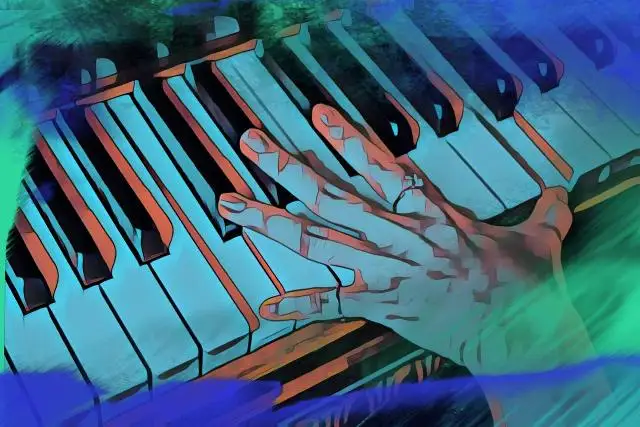Chord progressions are the building blocks of music. While we often rely on the accessibility and widespread appeal of major chord progressions, minor chord progressions are just as important for any musician. But how do minor chord progressions work? And how can you incorporate your own minor chord progressions into your music?
Below, we'll dive into everything you need to know about minor chords and share how you can start building your own minor chords and scales into your music.
Minor and Major Chord Progressions: What's The Difference?
In music, there are two major tonalities to consider when it comes to describing chords. Tonality refers to a method of describing the overall sound in a piece of music. So when it comes to chords, we usually think of minor or major as the main descriptors for identifying tonality in a chord progression.
Major chords usually depict a "happier" sound which is commonly heard throughout rock and pop music. Minor chords, however, are a little more complex and come with more depth which usually translates to a sadder or darker sound.
This is because minor chords naturally create more feelings of dissonance or tension in the way that they are built. Major and minor chords can share the same scale notes, though the context will determine whether the chord is major or minor. In this case, a chord might be referred to as a major chord's relative minor.
For instance, the C major scale ( C D E F G A B ) shares the same notes as the A minor scale ( A B C D E F G ), just in a different order and context. This makes A minor C major's relative minor chord. You could also say that C Major is the relative major of A minor.
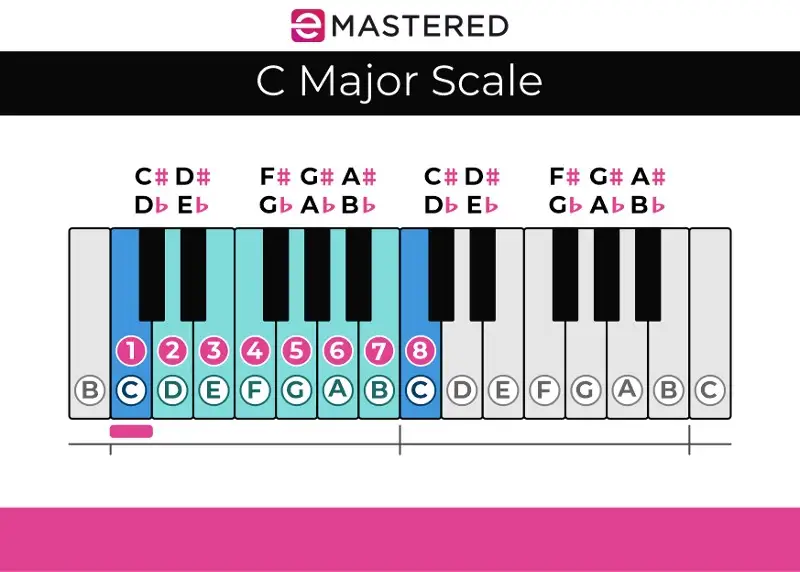
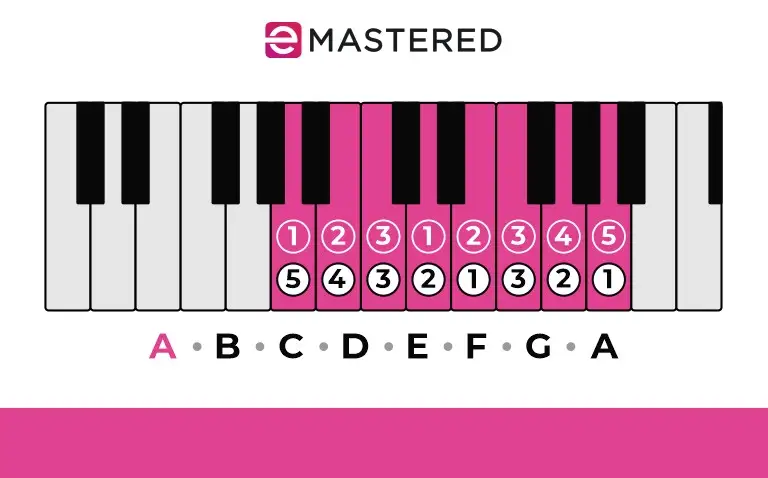
As you can see, these scales, despite being a major or minor key, showcase the same notes. The context of notes, or the order in which they're played, can totally define tonality.
Do you find yourself getting lost in music theory? Don't worry! The main point is to understand that major and minor chord progressions can share the same keys, and therefore the same set of notes. Therefore minor chord progressions aren't just defined by their notes, they are also categorized by the context in which they are played.
What Are Minor Chord Progressions?
Understanding how to write a chord progression is key to building a minor chord progression. To start, it's important to understand precisely what a chord is - a collection of three or more notes modeled after a particular scale, or collection of notes.
A chord progression is a group of multiple chords played in a specific order to evoke a certain feeling or mood. Just like notes, the context of chords matters. Chord progressions create different musical modes by emphasizing the relationship of notes throughout a key.
Simply put, a minor chord progression is a chord progression that is built off of a minor scale as opposed to major keys, which stem from a major scale. Chord progressions are defined by their prominent chords, or the i iv v (one, four, and five chords in a key). In a minor chord progression, these key chords are minor.
A chord degree simply refers to the order of chords in a progression. For instance, in A minor, the first chord is A minor, followed by the second chord B diminished. In E Minor, the first chord is E minor, followed by F# diminshed. Seem confusing? Don't worry! This pattern is a lot more straightforward than it seems, just note for now that chord progressions of any key go in a predictable order and are defined by the prominent chords of the minor key.
Understanding The Minor Scales
To build minor chord progressions, you'll have to be familiar with minor scales, since these note families are the building blocks of chords. Essentially, scales are collections of notes that hold certain relationships based on the key they're referring to.
A natural minor scale is created differently than a melodic minor scale. A harmonic minor scale is created differently than a melodic minor scale. Each scale type has its own identity that is universally understood by musicians.
However, the same scale can be translated across different keys. For instance, the C natural minor scale and G natural minor scale have different notes, but they both hold similar relationships between the notes because they were created utilizing the same type of scale. In this way, a scale is akin to a note formula or recipe.
Scales are built in full and half steps. A half step refers to up or down a sharp or flat. The distance between two half steps is one key. So on the piano, an adjacent black key and white key are each one half step apart. For example, the notes C and C# are one half step away from each other. Similarly, the notes D and D♭ are one half step away from each other.
A whole step consists of two half steps, or the distance of two adjacent keys on the piano. The notes C to D consists of a whole step, or F to G consists of a whole step.
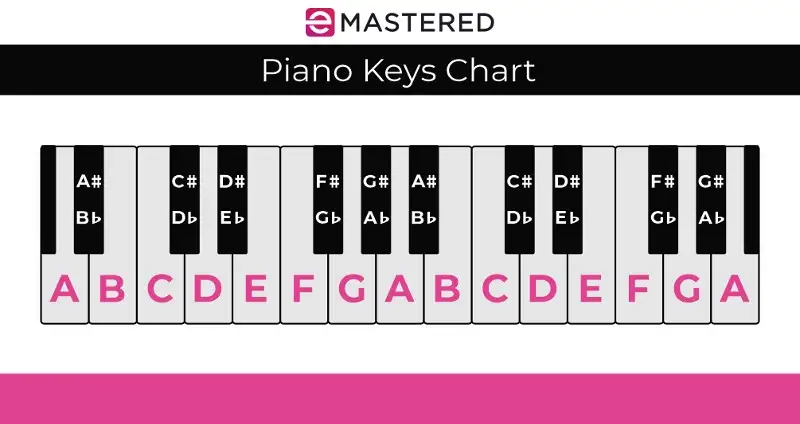
Understanding these two terms is key to building any major, minor, pentatonic, whole tone, harmonic, or any other scale for that matter. Scales are formulas built in the language and framework of whole and half steps.
To illustrate the art of making scales, we'll be using the notes in the Key of A minor, which utilizes no sharps or flats, otherwise referred to as accidentals, making our job easy. For reference, the natural key of A minor is spelled out as A B C D E F G A B.
Here are the most common types of minor scales that you'll come across while building minor chord progressions:
Natural Minor Scale
The natural minor scale has half steps between scale degrees 2 and 3, and 5 and 6. For example, if we look at the key of A minor, there is a half step as opposed to a whole step between notes B C and E F. If we look to the piano, B and C, and E and F are directly adjacent reflecting this principle.
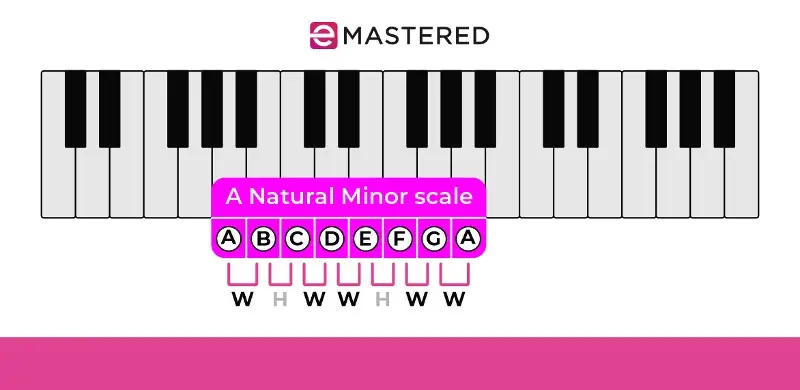
You can see the whole steps represented as "W" with "H" representing half steps.
Harmonic Minor Scale
To create a harmonic minor scale, the 7th note is augmented up an extra half step. In the key of A minor, this converts the G note to G#.
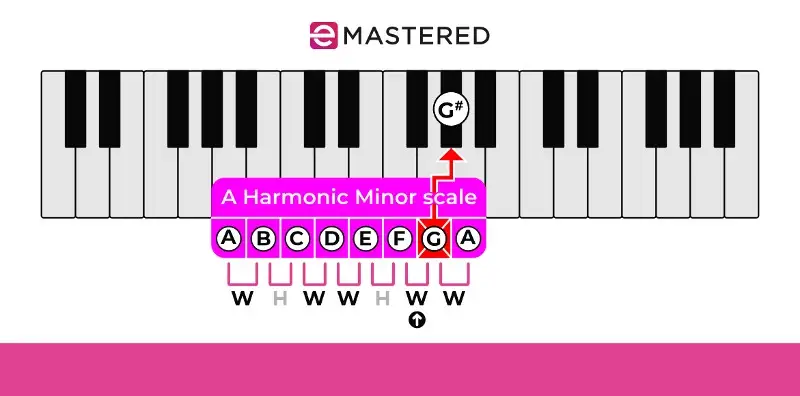
Melodic Minor Scale
The final version of a minor scale is a melodic minor scale which has an ascending and descending version. The ascending version has a sharpened 6th and 7th.
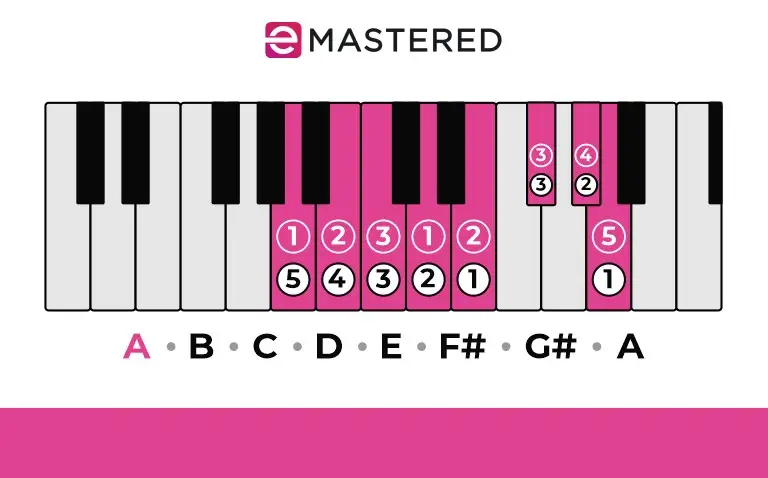
The descending version is essentially all natural notes in the context of the descending order:
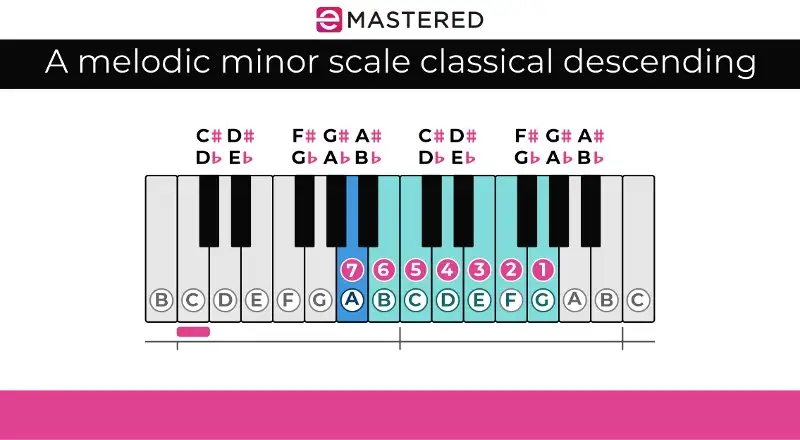
Find yourself getting lost? To sum up our findings thus far, a note makes up a scale or a collection of notes. These scales can be used to create chords, which can be reordered to create chord progressions.
In most cases, you'll be building minor chords using the natural minor scale, but it's worth understanding these variations throughout your career as a musician.
Understanding Minor Scale and Chord Degrees
How do musicians analyze and notate different scales and chord progressions within a song? While you don't necessarily need to grasp this information to build minor chord progressions, it's worth recognizing that this is done through a process called Roman numeral analysis. Understanding Roman numeral analysis can take some practice, but doing so will help you quickly understand the universal language of music.
You can identify chords in a song by their roman numerals. This notation can help you determine which scale degrees are minor, major, diminished, or augmented within a minor chord progression.
On a natural minor scale, the Roman numeral analysis looks like this:
i - Tonic (Minor)
iiᵒ - Supertonic (Diminished)
III - Mediant (Major)
iv - Subdominant (Minor)
v - Dominant (Minor)
VI - Submediant (Major)
VII - Leading tone (Major)
It can feel confusing to unlock these terms. After all, how could a major chord exist within a minor chord progression built off a minor scale? The answer lies in context. Major and minor chord progressions both share the same notes. It's the order that matters. That's why every major key has a relative minor, and every minor key has a relative major.
To identify a minor chord progression, you have to look at the most important scale degrees which are the tonic, dominant, and subdominant or i, v, iv. If it's a minor chord progression, these essential primary chords will be minor. The same goes for major chord progressions. Primary chords help us quickly identify the context of the chord progression.
Roman numeral analysis can help you quickly read and understand chord charts and popular chord progressions that are often written out in this manner. If you ever find yourself lost, remember that lowercase numerals note a minor chord, uppercase a major, and this symbol (ᵒ) paired with a lowercase numeral shows a diminished chord.
While these relationships may seem confusing at first, the good news is that this formula is universal for any note. You can use this scale formula and relationship to create a set of minor chords with any tonic starting note.
Examples of Minor Chord Progressions In Songs
Perhaps the best way to understand minor chord progressions is to hear them yourself. Minor chord progressions are becoming all the more common, even in genres like pop, thanks to the help of trap and rap music coming more into the limelight.
Here are a couple of songs you might not have known are in a minor key:
"Just Dance" by Lady Gaga
Lady Gaga's breakout song is in the minor key of C#m:
"Hotel California" by The Eagles
This classic Eagles' song is in the key of B minor:
"Baby One More Time" By Britney Spears
Britney Spears has multiple pop hits with minor chord progressions including "Baby One More Time" and "Toxic":
"Stronger" by Kanye West
Rapper and producer Kanye West has produced many chart-topping hits in minor keys, including the breakthrough single "Stronger":
How To Write Music In A Minor Key In 6 Steps
Without further ado, here's how to write music with a minor chord progression in 6 simple steps. The same process can be used to write a song with any type of progression, so feel free to swap out chords as you see fit.
1. Pick Your Key
To start, you have to find your key. You can build minor chord progressions from any key, but it might be easiest to start with A minor since this key has no sharps or flats. Alternatively, you might want to listen to songs in different keys and select your starting point based on your vocal range. Find a key in which you feel comfortable expressing yourself.
2. Build A Minor Scale
Once you've picked out your key, start to build a minor scale. You can use the natural minor, harmonic minor, or melodic minor scale as discussed above. To make things easy for yourself, it might make sense to start with the natural minor scale while you're getting your bearings.
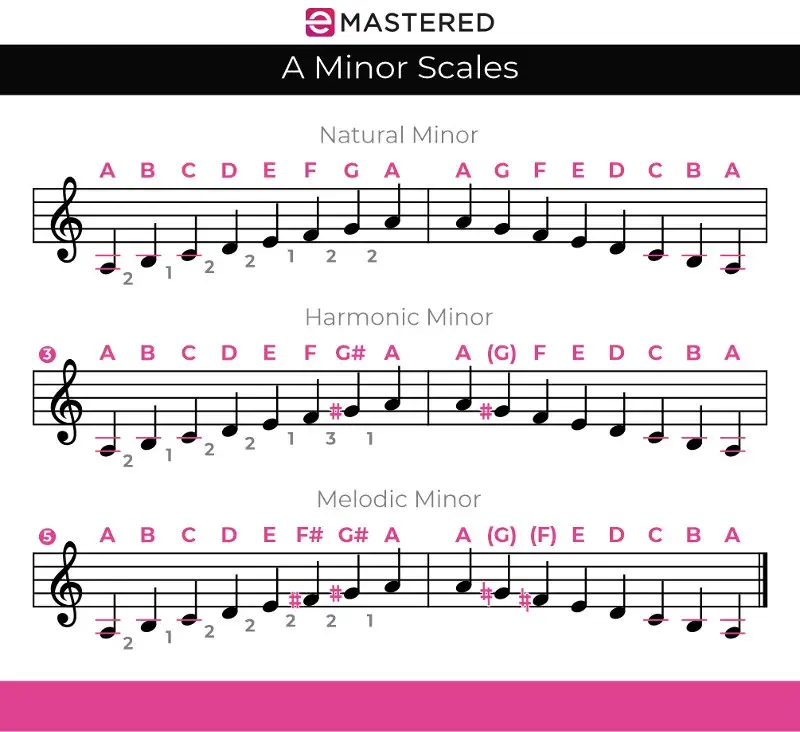
3. Build Minor Chords
Once you've built your minor scale, you can now write out your minor chords of the scale. To build basic chords, all you need is three or more notes stacked on top of one another in minor thirds.
For example, if we take the A minor natural scale, we can build A minor with the notes A, C, and E. Between each note is a minor third or three half steps. Major chords have four half steps between notes. To create G major, we would start with G, move up four half steps to get B, and four more to get D creating the chord triad G B D.
Using this formula, you can create minor chords for every scale degree. In A minor, chords according to their scale degree would look like this:
Am - Tonic (Minor)
B Dim - Supertonic (Diminished)
C - Mediant (Major)
Dm - Subdominant (Minor)
Em - Dominant (Minor)
F - Submediant (Major)
G - Leading tone (Major)
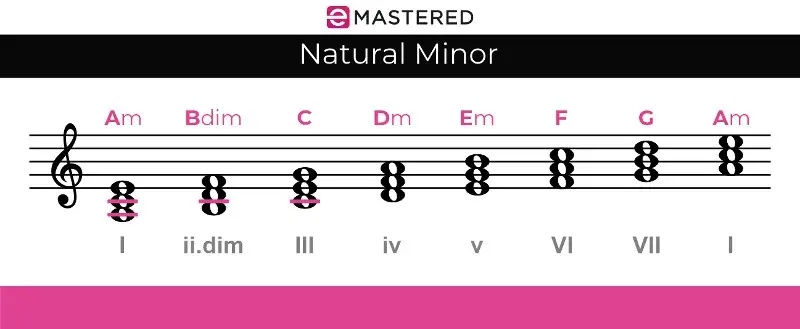
4. Create A Minor Chord Progression
Now that you've written out your chords for a specific key, it's time to create a progression! You can come up with your own combination of chords, or experiment with some of the popular chord progressions listed below.
While it's a good exercise to write out your chords so that you can understand the relationship between notes in the context of theory, you can also use a handy dandy chord sheet or chart like the one listed below to help you speed up your process of building chords in the key of your choosing.
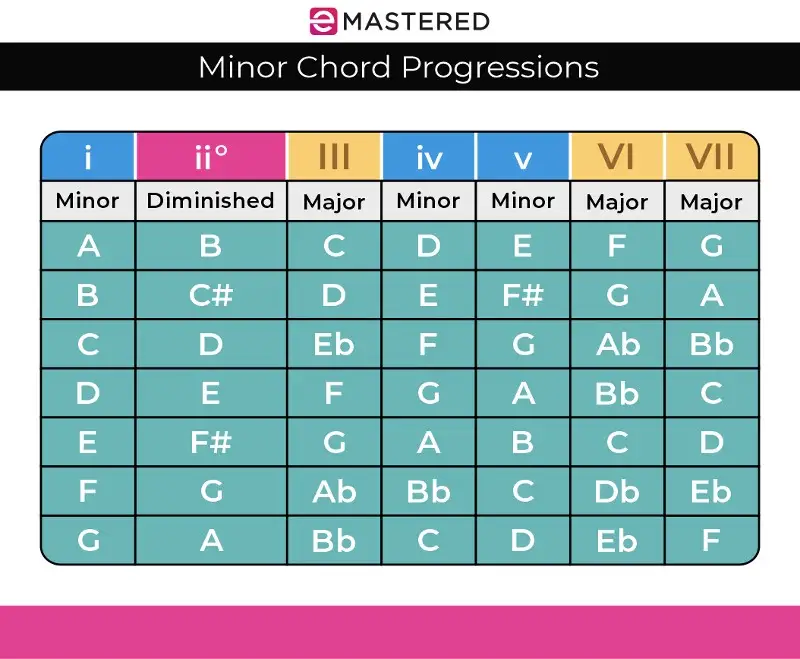
5. Test Your Progressions With Your Melody And Other Instrumentation
Chord progressions are crucial to making music, but they are just one component of modern song-making. Once you have a chord progression you want to try out, start layering it with your voice or other instrumentation like a guitar or piano melody.
You'll want to make sure that your melody fits within your chord progression. To do this, simply utilize notes within your key and scale in the song! Before you know it, you'll be able to write an entire song just by using three or four chords and a strong musical melody.
6. Experiment With Flourishes
Once you've built a chord progression and melody you're happy with, you can start to branch out by adding 7th or even 9th notes to your foundation chord triads to add some more depth. You can also create more complicated progressions that aren't just the same batch of chords repeated over and over.
Try using different chords during different sections of your song. Add in an extra chord, or hang on a chord longer for parts where your music needs extra emphasis. Now that you understand the basics, experiment with added notes to really make your chord progressions shine.
Common Minor Chord Progressions You Should Know
You can use a chord chart or simply experiment to start building minor chord progressions. With that in mind, here are some popular chord progressions that come up time and time again in minor songs.
i–iv–v
This classic progression is seen in many songs, including "Ain't No Sunshine" by Bill Withers:
The song is in the natural A minor key. It starts on an A minor chord, moving to E minor and D minor. This progression creates a sense of resolution and tension, giving it a mysterious, compelling aura.
i-VI- VII
This popular chord progression blends major and minor chords to create a compelling progression. Its seen all throughout pop music, but you can hear it through Gotye's "Somebody That I Used To Know" with Am, F, and G.
i- iv-i-VI-V7-i
This is the classic minor progression associated with 12 bar blues. A great example of a modern song utilizing 12 bar blues can be found in The White Stripes' "Ball and Biscuit":
i–iv–V7–i
This progression swaps out the classic minor five chord and replaces it with a major V7 chord to give a jazzier, more complex feel. You can here this chord progression in TLC's classic, "No Scrubs":
This jam also takes the 4 chord and adds a 7th. The progression moves from D minor, to A minor seventh, to E major seven, landing back on D minor.
i-v-VI
This progression is very similar to the first minor chord progression, though the v vi order is switched. With these three chords, you can make a wide variety of songs. Here's a video demonstrating just a few tunes you can play on the guitar with these minor chords.
i–VII–VI–VII–i
This progressions, and variations of it with substitue chords are fairly common in popular music. You can hear it directly in Green Day's "21 Guns":
i-iv-VI-v
Here is another minor chord progression variation that plays off of the three prominent minor tonic, dominant, and subdominant chords. You can hear this chord progression expressed in The Black Keys' "Fever":
As you can see, just as chord progressions are structured with major chords, most minor chord progressions are structured off variations of the i, iv, and v. This is not to say that you can't experiment with styles outside of the common chord progressions, but if you find yourself stumped, these chords are an excellent place to start.
Hopefully, this guide makes it easier for you to craft your own minor chord progressions for your music. The good news is that chords are universal, so whether your play guitar, piano, or just want to find a minor backing track for your voice, any minor chords will sound the same.
Feel free to experiment with your own chord progression combinations, even if it means playing outside the most popular chord progressions. You can also test your skillset with other major chord progressions or mix and match to create more complex soundscapes.
Have fun using minor chord progressions to make your music!


